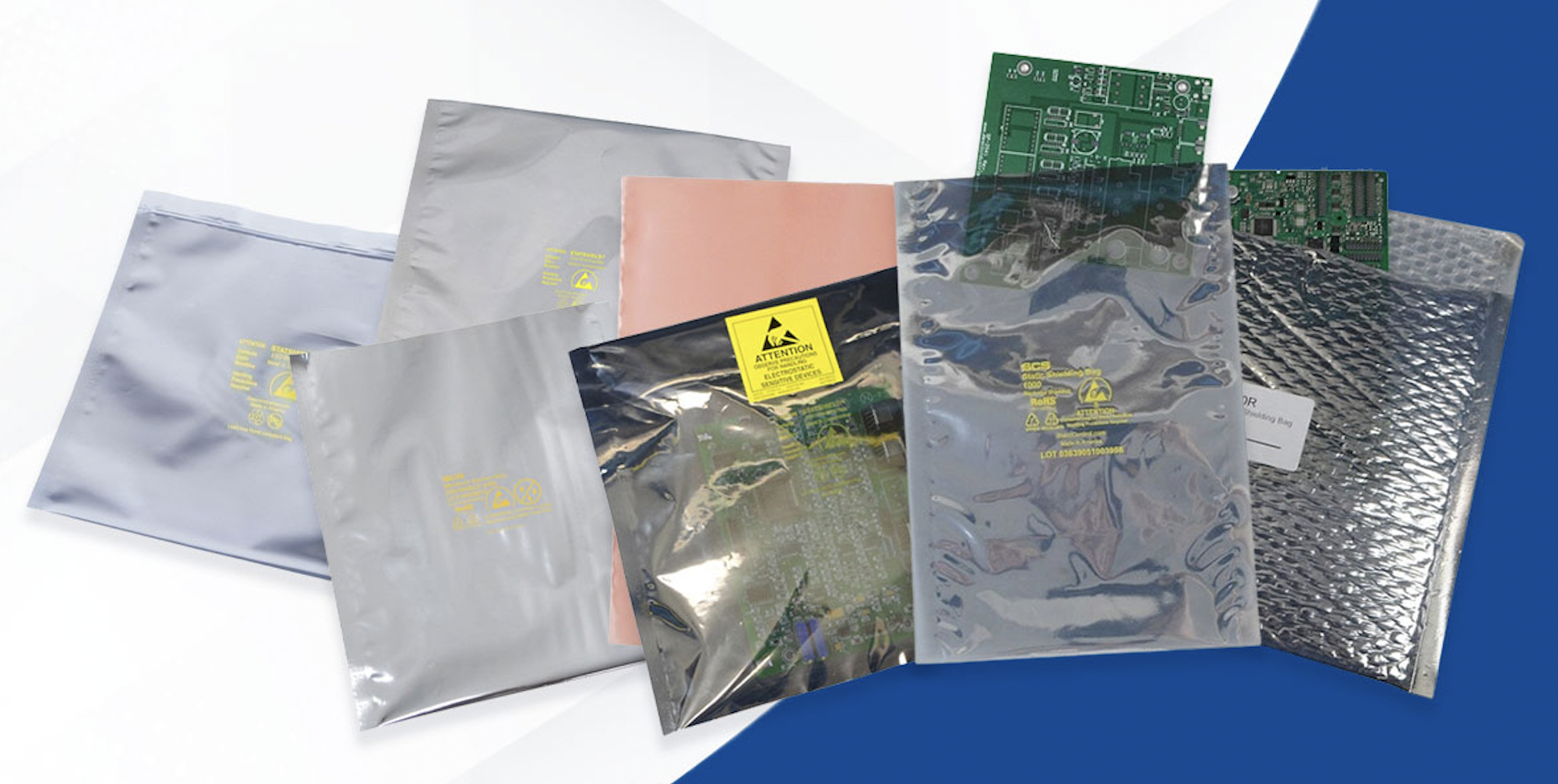
There are many types of electrostatic discharge (ESD) protective bags used in the electronic assembly manufacturing process today. ESD is a sudden flow of electricity between two objects at different electric potentials. It can occur when two objects with different electrical charges come into contact with each other, or when one object rubs against another. ESD can damage electronic components by causing their internal circuits to short out or overheat. Let’s look at some of the most popular choices to help determine what is right for you.
Static-shielding Bags
Static-shielding bags are used in electronics to protect electronic components from damage caused by ESD. Static-shielding bags work by creating a Faraday cage around the electronic components. A Faraday cage is a conductive enclosure that blocks the flow of electric fields. The static-shielding bag is made of a conductive material, such as aluminum foil, which creates a Faraday cage around the electronic components. This prevents ESD from reaching the components and damaging them.
Static-shielding bags are used in a variety of ways in electronics. They are commonly used to store electronic components, such as memory chips, processors, and capacitors. They are also used to transport electronic components, such as when they are shipped from one manufacturer to another. Static-shielding bags are also used to protect electronic components that are being used in a high-static environment, such as a manufacturing plant or a laboratory.
Here are some of the benefits of using static-shielding bags in electronics:
- They protect electronic components from damage caused by ESD.
- They help to extend the life of electronic components.
- They can help to prevent costly repairs or replacements.
- They can help to improve the quality of electronic products.
Static-shielding bags are an important part of protecting electronic components from damage. They are available in a variety of sizes with and without zipper closures. They are a cost-effective and easy way to improve the quality and reliability of electronic products.
Pink Poly Bags
Pink-poly bags are anti-static bags, which means that they are designed to prevent the buildup of static electricity. Static electricity can damage electronic components, so pink-poly bags can be a safe way to store and transport electronics.
However, it is important to note that pink-poly bags are not static-shielding bags. As noted above, static-shielding bags are designed to create a Faraday cage around the electronic components, which completely blocks the flow of static electricity. Pink-poly bags do not provide this level of protection, so they should not be used in high-static environments.
In general, pink-poly bags are safe to use in electronics. However, it is important to use them in the right environment and to take other precautions to protect your electronics from static electricity.
Here are some tips for using pink-poly bags safely:
- Use pink-poly bags in a low-static environment.
- Do not use pink-poly bags in a high-static environment, such as a manufacturing plant or a laboratory.
- If you must use pink-poly bags in a high-static environment, take other precautions to protect your electronics from static electricity, such as using a static-shielding bag or a grounding strap.
- Do not store or transport electronics in pink-poly bags for extended periods of time.
- If you are unsure whether or not it is safe to use pink-poly bags to store or transport your electronics, consult with a qualified electronics professional such as the experts at SMT Supplies.
Moisture-barrier Bags
Moisture-barrier bags are used in electronics to protect electronic components from moisture. Moisture can damage electronic components by causing corrosion, oxidation, and electrical shorts.
Moisture-barrier bags are made of a material that is impermeable to water vapor, such as polyethylene or polypropylene. The bags are sealed tightly to prevent moisture from entering.
Moisture-barrier bags are used in a variety of ways in electronics. They are commonly used to store electronic components, such as memory chips, processors, and capacitors. They are also used to transport electronic components, such as when they are shipped from one manufacturer to another. Moisture-barrier bags are also used to protect electronic components that are being used in a humid environment, such as a manufacturing plant or a laboratory.
Here are some of the benefits of using moisture-barrier bags in electronics:
- They protect electronic components from damage caused by moisture.
- They help to extend the life of electronic components.
- They can help to prevent costly repairs or replacements.
- They can help to improve the quality of electronic products.
Moisture-barrier bags are an important part of protecting electronic components from damage. They are a cost-effective and easy way to improve the quality and reliability of electronic products.
Here are some additional tips for using moisture-barrier bags:
- Make sure that the bags are properly sealed.
- Do not store or transport electronic components in moisture-barrier bags for extended periods of time.
- If you are unsure whether a moisture-barrier bag is suitable for your needs, consult with the experts at SMT Supplies.
There are a variety of ESD protective bags available to the electronic assembly industry today. Consult with the experts at SMT Supplies to determine which bags will best suit your needs.